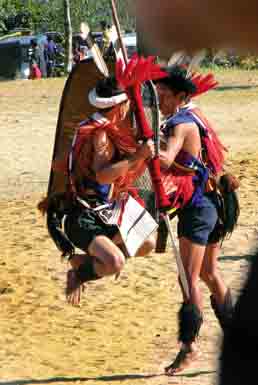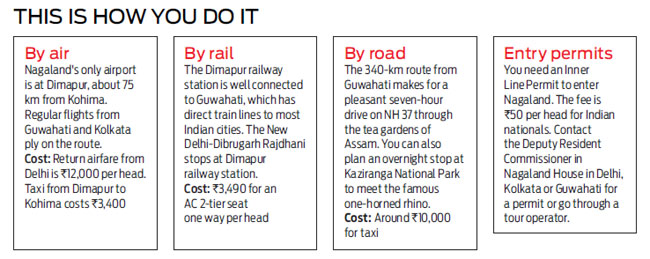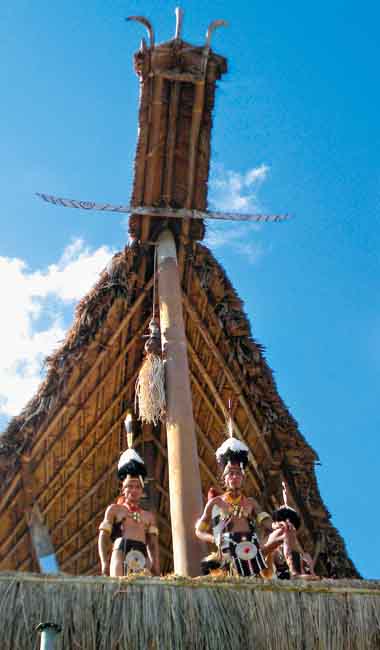When the hornbill calls
Festival of festivals is the Hornbill Festival. Rice beer, colourful dances, contest and many more will give the new face of any tradition.
 Yes, India’s northeast, or parts of it, is still off the tourist circuit, in particular the land of the Nagas. Every December, Nagaland comes together to celebrate its unique tribal cultural heritage with the Call of the Hornbill festival. And this makes it the ideal time to head for this border state that has been kept off the travel map. If you are looking for the exotic and the unusual, head for the green valleys that lie beyond Assam. But why does the hornbill call? The large and colourful forest bird, which finds the pride of place in the folklore in most of the state’s 16 major tribes and the numerous sub-tribes, calls the people of Nagaland, and tourists, to this 10-day “Festival of Festivals”. Held at the Naga Heritage Complex at Kisama, about 12 km from the state capital of Kohima, the festival provides a ringside view to the ethnic dance and dress, craft and culinary skills of a dozen-odd Naga tribes.
Yes, India’s northeast, or parts of it, is still off the tourist circuit, in particular the land of the Nagas. Every December, Nagaland comes together to celebrate its unique tribal cultural heritage with the Call of the Hornbill festival. And this makes it the ideal time to head for this border state that has been kept off the travel map. If you are looking for the exotic and the unusual, head for the green valleys that lie beyond Assam. But why does the hornbill call? The large and colourful forest bird, which finds the pride of place in the folklore in most of the state’s 16 major tribes and the numerous sub-tribes, calls the people of Nagaland, and tourists, to this 10-day “Festival of Festivals”. Held at the Naga Heritage Complex at Kisama, about 12 km from the state capital of Kohima, the festival provides a ringside view to the ethnic dance and dress, craft and culinary skills of a dozen-odd Naga tribes.

What would have taken numerous journeys into jungles to discover is on display in a well-organised and enjoyable event. The Hornbill festival is a colourful mixture of dances, food fairs and games, all centered around 16 morungs or pavilions shaped like a tribal pub. Each morung doubles up as a small exhibition hall and a café for the tribe invited to the festival. If you have an eye for the unconventional, there are the popular chilli eating and pole climbing contests. Wash all that fun down with rice beer, distilled in 16 distinct ways!

All this is just at half an hour's drive from Kohima. Perched at a height of 4,000 feet, the state capital is a flourishing town of close to 80,000 people. It  boasts of quite a few swanky hotels and all amenities (though power supply is a bit erratic). Kohima has found its way into the history books as the site of the major battle that stalled the march of Japanese into India during the World War II in 1944. More than 4,000 British troops died in what was termed as 'Britain’s Greatest Battle'. The war cemetery on the Garrison Hill is a must visit as if you have the stomach for it, there is the popular chilli-eating contest. Wash the fury down with rice beer, distilled 16 distinct waysis the well-maintained war museum at Kisama. During the Hornbill festival, Kohima, too, is in a festive mood.
boasts of quite a few swanky hotels and all amenities (though power supply is a bit erratic). Kohima has found its way into the history books as the site of the major battle that stalled the march of Japanese into India during the World War II in 1944. More than 4,000 British troops died in what was termed as 'Britain’s Greatest Battle'. The war cemetery on the Garrison Hill is a must visit as if you have the stomach for it, there is the popular chilli-eating contest. Wash the fury down with rice beer, distilled 16 distinct waysis the well-maintained war museum at Kisama. During the Hornbill festival, Kohima, too, is in a festive mood.
While most shops and restaurants close by 6 pm, the Night Carnival or Night Bazaar hosts hundreds of food stalls. Here you can find several varieties of meat cooked in Naga style. There’s pork, dog, duck, snails and, of course chicken, which is barbecued, boiled, or fermented in bamboo stems (pongsten). For a more authentic ethnic feel, you can go on day-trips to Khonoma and Tuophema villages. While Khonoma is only 18 km away, Tuophema is more than 40 km from Kohima, and the roads are far from smooth. But the bumpy ride to Khonoma is worth it as it is one of the first green villages of the country. A guided tour through this village that defeated the British twice and still preserves the tribal customes will give you an understanding of the tribal way of life.









